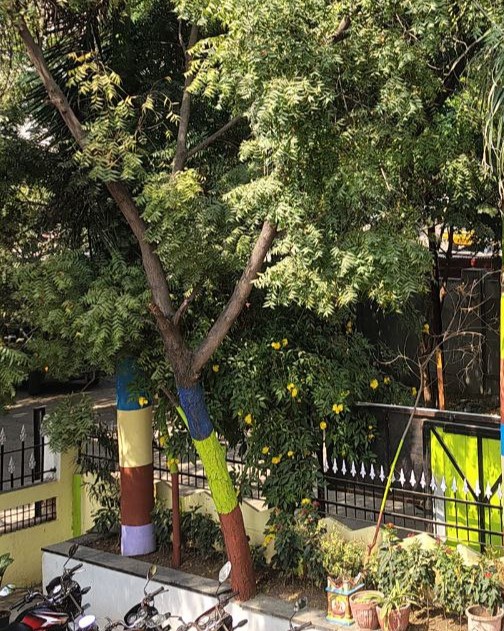Green Campus/Tree Details

कडुनिंब झाड (Neem tree )
कडुनिंब (Azadirachta indica), ज्याला "निंबाचा राजा" असेही म्हटले जाते, हा भारतीय उपखंडातील औषधी गुणधर्मांसाठी ओळखला जाणारा एक महत्वाचा झाड आहे. कडुनिंबाला "गावाचा औषधालय" (Village Pharmacy) असेही म्हटले जाते कारण याचा उपयोग अनेक प्रकारच्या आजारांवर केला जातो.
शारीरिक वैशिष्ट्ये
-
उंची आणि रचना:
- कडुनिंब झाड 15-30 मीटर उंच वाढते आणि याचा पसरट पर्णसंभार असतो.
- याची फांद्या दाट हिरव्या पानांनी झाकलेली असतात.
-
पाने:
- पाने 20-30 छोट्या पानांच्या जोड्यांनी बनलेली असतात. ती चमकदार हिरवी असून कडसर असतात.
- पानांमध्ये औषधी गुणधर्म असतात.
-
फुले:
- कडुनिंब झाडावर लहान, पांढऱ्या आणि सुगंधी फुले येतात.
- फुले वसंत ऋतूमध्ये येतात आणि मधमाशा याकडे आकर्षित होतात.
-
फळे:
- झाडाला लहान, पिवळसर-हिरवी फळे लागतात ज्यामध्ये एक बी असते. बींमध्ये तेल भरपूर प्रमाणात असते.
कडुनिंबाचा उपयोग
1. औषधी उपयोग:
कडुनिंबाचा उपयोग आयुर्वेद, युनानी आणि पारंपरिक औषधांमध्ये होतो.
- पाने: त्वचारोग, संसर्ग आणि रोगप्रतिकारक शक्ती वाढवण्यासाठी उपयुक्त.
- तेल: केसांची निगा, त्वचारोग उपचार, तसेच जखमांवर उपयुक्त.
- झाडाची साल: दातांच्या आरोग्यासाठी आणि ताप कमी करण्यासाठी.
- फुले: पचन सुधारण्यासाठी वापरतात.
2. पर्यावरणीय महत्त्व:
- हवा शुद्धीकरण: कडुनिंब हवेतील विषारी घटक काढून टाकतो.
- कीटक व्यवस्थापन: कडुनिंबाचे तेल व अर्क नैसर्गिक कीटकनाशक आहेत.
3. सांस्कृतिक व धार्मिक महत्त्व:
- कडुनिंब झाडाला पवित्र मानले जाते आणि विविध धार्मिक विधींमध्ये याचा उपयोग होतो.
4. शेतीतील उपयोग:
- कडुनिंबाच्या पेंडेमुळे (oil cake) खत तयार होते.
- झाडांवरील कीड टाळण्यासाठी कडुनिंबाचे अर्क उपयुक्त ठरतात.
5. इतर उपयोग:
- कडुनिंबाचे लाकूड फर्निचर व घर बांधकामासाठी वापरले जाते.
- दात घासण्यासाठी कडुनिंबाच्या काड्या उपयोगात आणल्या जातात.
लागवड व देखभाल
- हवामान: कडुनिंब उष्ण कटिबंधीय हवामानात चांगले वाढते.
- माती: वाळूसारखी किंवा गाळयुक्त माती याच्या लागवडीस योग्य असते.
- पाणी: झाड लहान असताना नियमित पाणी द्यावे लागते.
आरोग्य फायदे
- त्वचेसाठी: मुरुम, खाज आणि सोरायसिससाठी उपयुक्त.
- ओठ आणि हिरड्यांचे आरोग्य: कडुनिंबाच्या काड्या हिरड्यांचे आजार दूर करतात.
- रक्तशुद्धी: कडुनिंबाचे पानांचे रस रक्त शुद्ध करतो.
- रोगप्रतिकारक शक्ती: संसर्गांवर मात करण्यास मदत होते.
निष्कर्ष
कडुनिंब हे झाड औषधी, पर्यावरणीय आणि आर्थिक दृष्टिकोनातून अमूल्य आहे. त्याचे सर्व भाग उपयुक्त असून, कडुनिंब मानवजातीसाठी वरदान आहे. भारतात याला प्राचीन काळापासून एक पवित्र झाड मानले गेले आहे, आणि आधुनिक काळातही त्याचे महत्त्व कमी झालेले नाही.
Neem tree (Azadirachta indica), commonly known as the "Indian Lilac," is a fast-growing, evergreen tree native to the Indian subcontinent. It is well-known for its medicinal properties, ecological benefits, and economic uses. Neem is regarded as sacred in many cultures and is often referred to as the "Village Pharmacy" due to its wide-ranging therapeutic applications.
Physical Characteristics
-
Height and Structure:
- Neem trees typically grow up to 15–30 meters in height with a wide spreading canopy.
- Its branches are covered with dense, green leaves that provide ample shade.
-
Leaves:
- The leaves are pinnate, with 20-30 medium-sized leaflets. They are bright green and slightly serrated along the edges.
- Neem leaves are bitter and have powerful medicinal properties.
-
Flowers:
- Neem produces small, white, fragrant flowers during the spring.
- These flowers attract bees and other pollinators.
-
Fruits:
- The fruits are small, yellowish-green drupes containing a single seed. The seeds are rich in oil.
Uses of Neem Tree
1. Medicinal Benefits:
Neem is a cornerstone in traditional medicine systems like Ayurveda and Unani.
- Neem Leaves: Used to treat skin conditions, boost immunity, and manage infections.
- Neem Oil: Extracted from seeds, it is widely used for skin care, hair care, and treating fungal infections.
- Neem Bark and Root: Used for dental hygiene (as tooth powder or paste) and fever treatment.
- Flowers: Often used in herbal remedies for digestive disorders.
2. Ecological Importance:
- Air Purification: Neem is known to purify the air and is often planted in urban areas for this reason.
- Pest Control: Neem oil and neem-based sprays are natural pesticides.
3. Cultural and Religious Significance:
- Neem is considered sacred and is associated with goddess Durga in Hindu mythology.
- Its branches and leaves are used in various religious rituals.
4. Agricultural Benefits:
- Neem cake (the residue left after oil extraction) is a natural fertilizer.
- Neem extracts act as biopesticides, protecting crops from pests.
5. Other Uses:
- Neem wood is used for furniture and construction due to its resistance to termites.
- Neem twigs are traditionally used as toothbrushes.
Planting and Cultivation
- Climate: Neem thrives in tropical and subtropical climates, with temperatures between 25–35°C.
- Soil: It grows well in sandy, loamy, or clay soils.
- Watering: Although drought-tolerant, neem requires adequate watering during its early stages.
Health Benefits
- Skin Care: Treats acne, eczema, and psoriasis.
- Oral Hygiene: Neem twigs prevent cavities and gum diseases.
- Blood Purification: Consuming neem leaf extracts purifies the blood.
- Immunity Booster: Helps in fighting infections.
